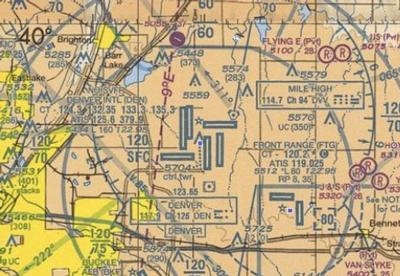Airline Attributes Program Success To Partnerships With Denver ARTCC, Denver TRACON, Denver ATCT, And Denver International Airport
Southwest Airlines is flying fuel efficient and environmentally friendly Required Navigational Performance (RNP) approaches at Denver International Airport (KDIA). RNP approaches can reduce flying by 3-5 miles during a visual approach and up to 20 miles during an instrument approach each time they are flown at KDIA. These flights follow highly predictable paths and allow descents at idle power from high altitude cruise, which is the quietest and most fuel efficient way for an aircraft to arrive. Working closely with local and regional FAA and KDIA officials, major contributions have been made to the development of those procedures as part of an ongoing major redesign of the airspace at KDIA.

"We are very grateful to Southwest for their partnership with us, the FAA and others who were instrumental in the design and implementation of this essential phase of NextGen at KDIA," said Denver's Manager of Aviation, Kim Day. "In fact, our team composed of representatives from Southwest and other airline partners, consultants, KDIA and FAA was recently honored by the Air Traffic Association for the unprecedented partnership that redesigned Denver's airspace. Many thanks to Southwest for their continued collaboration and support!"
RNP procedures at KDIA have the potential to save Southwest Airlines an estimated 20 gallons of fuel per flight on visual approaches and more than 90 gallons of fuel per flight on instrument approaches. The carrier has committed a substantial amount of resources toward engineering and computer modeling, as well as flight simulator and flight trials, to support the advancement of RNP approaches.
"Southwest is playing a major role in supporting FAA development of RNP procedures, which benefit the industry as a whole, as well as the communities we serve," said Rick Dalton, Southwest Airlines Director of Airspace and Flow Management. "These efficient RNP approaches reduce noise and carbon emissions, allowing carriers to pass on efficiencies to their Customers, and the current successes of this program could not have been achieved without the support and leadership of the Denver TRACON, the Denver Air Route Traffic Control Center, and Denver International Airport."
Southwest is a nationally recognized leader in RNP implementation and is working alongside the FAA, airport officials, and industry stakeholders as the lead carrier to develop and implement more than 150 RNP procedures for public use at 40 airports across the nation. RNP Authorization Required (AR) procedures are high-performance, GPS-based, continuous-descent approaches that improve safety, reduce carbon emissions, and are designed to conserve fuel characteristics that exist in an airline's fleet.

"Cooperation between carriers and the FAA is vital for the success of NextGen across the system," Dalton said. "Southwest looks forward to continued partnerships with the FAA and airport officials as we work toward a modernized air traffic control system by continuing to develop RNP procedures."
In 2011, Southwest Airlines began flying RNP routes at 11 airports across the country after retrofitting 345 737-700 Boeing aircraft with advanced avionics and training nearly 6,000 Pilots and 200 Dispatchers. Today, Southwest Airlines continues to support the development of RNP procedures, with the goal of operating RNP approaches at all 96 airports it currently serves.
 ANN's Daily Aero-Term (05.05.25): Circle To Runway (Runway Number)
ANN's Daily Aero-Term (05.05.25): Circle To Runway (Runway Number) ANN's Daily Aero-Linx (05.05.25)
ANN's Daily Aero-Linx (05.05.25) NTSB Prelim: De Havilland DHC-1
NTSB Prelim: De Havilland DHC-1 Classic Aero-TV: The Boeing Dreamliner -- Historic First Flight Coverage
Classic Aero-TV: The Boeing Dreamliner -- Historic First Flight Coverage Airborne-NextGen 05.06.25: AF Uncrewed Fighters, Drones v Planes, Joby Crew Test
Airborne-NextGen 05.06.25: AF Uncrewed Fighters, Drones v Planes, Joby Crew Test




